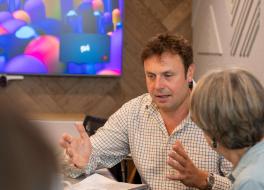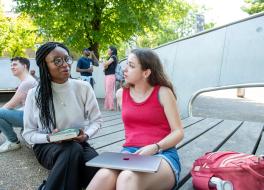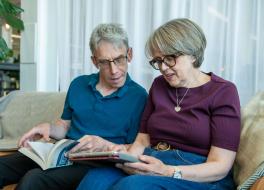Self-advocacy for people who stammer

In this article from our archive, St. John Harris reflects on a therapy course aiming to help people speak up for themselves by exploring the 'social model' of stammering.
In Autumn 2000, I attended a ground-breaking course at the City Lit in London called 'Self-advocacy for People who Stammer'.
Why self-advocacy?
When applied to stammering, self-advocacy is about people who stammer speaking up for themselves, relating their stories, being true to themselves and asking for what they need.
A key goal of mine has been to be more honest and self-accepting about my stammer. The more open I become, the more objectively I can focus on the physical act of stammering as a basis for modifying my speech. This process of 'desensitisation' is hard work.
We were told during the first session that we were in for the long haul. The familiar image is of the iceberg: below the surface lies a dark mass of negative feelings and avoidance behaviour, and above, the dysfluency which, despite my vigilance, can break out at any time.
The social model takes the power to decide who is disabled away from the expert and returns it to the individual.
The self-advocacy course gave me a valuable opportunity to question all the negative emotional baggage and to review my identity as a person who stammers. I wanted to challenge received notions and stereotypes, and to embrace new possibilities and ideas.
Course outline
The first half of the course concentrated on giving us the theoretical tools to help us understand stammering and address questions of identity.
We were then guided through the difficult and potentially awkward topic of 'being different'. Language, accents, ethnicity and sexuality are some of the ways we can feel different from the majority. We inevitably felt a little tentative discussing such personal issues. However, a common theme emerged of a deep-seated urge to blend in with the majority and to minimise the effect of difference.
From difference in general, the discussion naturally led to stammering and the similar urge to cover it up. What are the advantages and the drawbacks of maintaining a fluent facade?
Disability
This examination of difference paved the way nicely for what was for me the most fruitful and important theoretical issue in the course: disability. Most of my colleagues were happy to discuss stammering as a disability, but some resisted the association and were not prepared to address the 'problem' of stammering in these terms.
I have recently come to the conclusion that it doesn't make much sense to pose the question: is stammering a disability? This is principally because the very definition of disability is open to question and to choice. But if you do deny stammering is a disability, you deny yourself a conceptual framework in which to say many useful and worthwhile things about stammering.
As John Swain and Colin Cameron have argued: "Perhaps the most significant consequence of coming out, apart from the positive impact the process has for the personal identities of disabled people themselves, is that, in the act of coming out we are changing the very meaning of disability."
I have recently come to the conclusion that it doesn't make much sense to pose the question: is stammering a disability?
The struggle to be more positive and open about stammering is reflected for me at least in the conceptual struggle to embrace a transformed meaning of disability. There are profound connotations from which the term and therefore the experience of disability will never be free: not able, not whole, not normal.
Medical vs social model
We examined the conflicting positions defined by where each locates the 'problem' of disability. According to the medical model, the problem is the individual's impairment which should, if at all possible, be cured. By contrast, the social model views the problem as environmental, located within society and society's attitudes towards the impairment which the individual internalises. But neither model can be applied simplistically, especially in the case of stammering, where the relationship between the disability and the impairment is so complex.
What the social model does achieve is to take the power to decide who is disabled away from the medical expert, and return it to the individual. My disability is defined by the degree of social oppression I feel with regard to my impairment. In my experience, and I believe in the case of many people who stammer, this is largely self-oppression - the internalisation of negative attitudes about stammering. A curious aspect of my dysfluency is that the self-oppression goes to the heart of the physical impairment. In the words of the speech pathologist, Wendell Johnson: "Stuttering is what you do trying not to stutter again."
Barriers
We then proceeded to explore the 'disability' of stammering further, understood as the interaction between impairment and the diverse barriers we face in the physical and social world. Barriers come in various forms, for example one environmental barrier is the answerphone which does not give me enough time to finish my message.
The most pertinent for the group were the attitudinal barriers to stammering - other people's unhelpful attitudes and our own limiting self-beliefs. We spent much of the session thinking of how to address these. Openness and assertiveness both emerged as key qualities, as was the ability to recall positive role models of people who stammer.
But where are these positive images to be found? We discussed the portrayal of stammering in the media, as part of the wider picture of cultural representations of disability. Two particularly stark stereotypes were the stammerer as deranged and violent victim turned aggressor in Prime Suspect and Cracker and the stammerer as an object of ridicule in A Fish Called Wanda. In both instances, the image of dysfluency is distorted and exploited for either dramatic or comic effect.
Such media images both reflect and perpetuate deeply ingrained cultural 'narratives' about disability. No wonder, according to Sally French: "Most people have a rather simplistic and superficial understanding of disability." Very rarely do we see in the mainstream media, representations which do justice to the complexity of stammering.
I feel more relaxed and confident about my identity as a disabled individual.
In a later session we looked at self-expression, trying to articulate visually the significance of stammering in our lives. Some found the exercise enormously liberating, giving free rein to the imagination to express profound emotions in a very vivid and immediate manner.
In the penultimate session, in vox pop style, we each sat in front of the video camera to have 'our shout' about stammering. This was a more focused attempt to counter unhelpful misconceptions and attitudes. Although each of our shouts delivered a different message, common threads ran throughout: "Don't jump to any conclusions about me", "Give me a chance to have my say"; and "Don't laugh at me." The individual shouts seemed to mesh effectively into a collective voice.
By the time we reached the final session and were reviewing our progress, I felt we had worked hard both as individuals and as a group to build alternative narratives about stammering. Carol Thomas notes that self-affirming narratives: "Once re-forged, are not fixed and static - they have to be continually worked at if they are to be sustained in the face of more dominating disablist social narratives." The group turned out to be a powerful means of assessing negative attitudes towards stammering and developing a positive response, even if we could not agree about its status as a disability.
Reflection
Personally, I have improved my grasp of disability issues, and feel more relaxed and confident about my identity as a disabled individual. The amount of theory on the course was not to everyone's taste - therapists may wish to downplay this aspect accordingly. However, without the theory I believe I could not have attained the same degree of awareness of the challenges of stammering, self-identity and disability. Challenges, not solutions. There is no right way to cope with or indeed to regard stammering, but there are plenty of wrong ways, perpetuated by therapies which can inflict untold damage on people's lives. For example, stammering therapy courses which are based on the aggressive application of the medical model of disability can begin by demonising stammering. They make much of the plight of the stammerer and their inferior status, and then set out to slay the monster. There is no middle ground between abject failure and the dizzying heights of success effected by their 'cure'.
A grounding in disability theory is a good way of deepening therapists' understanding of the essential paradox of stammering summed up by Wendell Johnson: a paradox which has ramifications on all levels of stammering therapy. This I would argue is the most valuable aspect of the course; maybe not for all clients, but certainly of the widest relevance to speech and language therapists.
References
Fraser M. Self-Therapy for the Stutterer. Memphis, Tennessee: Stuttering Foundation of America, 1993.
French S. What is Disability? On Equal Terms: Working with Disabled People. Oxford: Butterworth-Heinemann, 1994.
Swain J, Cameron C. Unless otherwise stated: discourses of labelling and identity in coming out. Disability Discourse. Buckingham: Open University Press, 1999.
Thomas C. Narrative Identity and Disabled Self. Disability Discourse. Buckingham: Open University Press, 1999.
© Copyright Royal College of Speech and Language Therapists, 2001.
This is an edited version of an article which was first published in The Bulletin, Royal College of Speech & Language Therapists.
This article featured in the Summer 2002 edition of our old magazine, Speaking Out. The course mentioned may no longer be running - for more information about City Lit courses, visit their website.






























